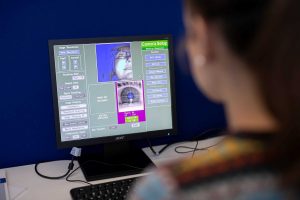

in File menu in the editing window, or Save>Save as short text file. When you're done with the transcription phase, you can save your TextGrid in a compact form using File>Save TextGrid as text file. This should be enough of an introduction to get you started - for more help, try trial-and-error, or ask your TA, or ask a question on the course Canvas page.Ħ. So after a few more iterations of the same thing, you might have something like this: Or you can zoom in and out with the "in" and "out" buttons: You can move around in the recording with the slider: If you click on that bar segment, the selected region will be played:ĥ. For example, here's the region corresponding to the word "we're" - the bar indicated by the red arrow tells you that the duration of this region is about 210 milliseconds. This will establish a transcript segment from the previous segmentation point to the current cursor, labelled with whatever you type before hitting RETURN:īefore going on, spend a little time picking out different parts of the audio using click-and-drag motions of the mouse, and see if you can find specific syllables or words or word sequences, checking what you've found by playing selected region. Type (or cut-and-paste) the transcript, and hit RETURN. Now place the cursor at the end of the visible audio region - by putting the mouse pointer where you want it to go, and clicking to set the cursor. The display should look something like this: This will create a blank label in the TextGrid, from the start of the file to the point where you placed the cursor. Now place the mouse pointer at the start of Obama's vocalization, click, and hit RETURN. W- we're gonna have to act- work smarter, we're gonna have to As you can hear, Obama says something like If you click on the region towards the bottom of the display, labelled "Visible part X.XXXXXXXX seconds", the program should play the portion of the recording that you're seeing. The result will look something like this: Then click on the "sel" (for "select") button. Click and drag (left-click on Windows) to highlight the first "breath group" (region between silent pauses) in the waveform pane. The bottom pane (here in yellow) is where you'll put the transcription.Ħ. The middle pane is the "spectrogram", about which more in a later lesson.

The top pane is the "waveform", which shows time left-to-right, and the local value of the sound signal (deviations from ambient air pressure) in the up-and-down dimension. Now click on "View & Edit", and a new window labelled "2. Sound ObamaMTP092014x" item, after which the (top of the) Praat Objects window should look like this: "Command-click" (on Mac) or "control-click" (on Windows) on the "1. Now the (top of the) "Praat Objects" window should look like this: This causes a box to pop up that looks like this:Īnd click "OK". Click on the "Annotate -" button:Īnd then select "To TextGrid." from the resulting pop-up menu: Set up to edit a "TextGrid" associated with the audio file. Now the Praat Objects window should look like this:ĥ. to browse to wherever you put the ObamaMTP092014x.wav file, and open it. Click on the "Open" menu in the "Praat Objects" window, and use Open>Read from file. Open the ObamaMTP092014x.wav file in Praat. Get rid of the "Praat Picture" window, as you won't be using it for this exercise.Ĥ.

#LING UCLA PRAAT WINDOWS#
Two windows will appear, labelled "Praat Objects" and "Praat Picture".
#LING UCLA PRAAT DOWNLOAD#
Download ObamaMTP092014x.wav, the audio file to be transcribed, into an appropriate folder.ģ. On the other hand, you may well choose to build on what you've learned in this exercise when it comes time to do your Final Project.Ģ. The good news is that it's not a lot harder to do some very sophisticated things - but you won't get to that part of the Praat experience in this exercise, alas. I'm sorry to say that the design of Praat makes it much harder than it should be to do some very simple things. These are instructions for using the program Praat to create a simple transcription, aligned phrase-by-phrase or word-by-word with an audio file, as required by Homework 4 for Linguistics 001, Fall 2015 edition.


 0 kommentar(er)
0 kommentar(er)
